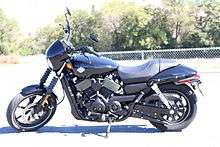Harley-Davidson Street
The Harley-Davidson Street motorcycle series was announced by Harley-Davidson at the 2013 EICMA show in Milan for 2014 introduction, Harley's first all-new models in 13 years,[1][3] including Harley's first lightweight motorcycle since the 1974 Sprint.[5] The 750 is powered by a 749 cc displacement version of Harley's 60° SOHC V-twin, water-cooled Revolution engine dubbed the Revolution X. The Street 500 has a 494 cc engine with a smaller bore but is otherwise identical.[1] Production for sale in the United States and Canada is done at Harley's Kansas City facility; production for the rest of the world, including engines, is done at the Harley-Davidson India subsidiary in Bawal with indigenous components.[3][6] Street series bikes are positioned as Harley's entry-level models, with a price point that is the lowest for Harley's US lineup by over $1,200.
 | |
| Manufacturer | Harley-Davidson |
|---|---|
| Production | 2014–present |
| Assembly | Kansas City, Missouri, USA (US, Canada and Mexico)[1] Bawal, India (rest of world)[1] |
| Class | Cruiser |
| Engine | 60° SOHC, water-cooled V-twin with balance shaft Street 750:749 cc (45.7 cu in) Street 500: 494 cc (30.1 cu in)[1] |
| Bore / stroke | Street 750: 3.35 in × 2.60 in (85.0 mm × 66.0 mm) Street 500: 2.72 in × 2.60 in (69.0 mm × 66.0 mm) |
| Compression ratio | Street 750: 10.5:1[2] |
| Power | 53 hp (40 kW) @ 8,000 rpm (Street 750) |
| Torque | 47.9 lb⋅ft (64.9 N⋅m) @ 4,000 rpm (Street 750)[3] |
| Transmission | 6 speed, belt drive |
| Frame type | Steel |
| Suspension | Front: Telescopic forks Rear: Dual shocks, box section swingarm |
| Brakes | Front: Single-caliper disc Rear: Single-caliper disc |
| Tires | 100/80x17 150/70x15, 140/75R15 |
| Rake, trail | 32°, 4.5 in (110 mm)[2] |
| Wheelbase | 59.5 in (1,511 mm) |
| Dimensions | L: 87.6 in (2,226 mm) W: 32.1 in (815 mm) H: 27.9 in (709 mm) |
| Seat height | 25 in (640 mm) |
| Weight | 480 lb (220 kg) (claimed)[1][4] (wet) |
| Fuel capacity | 3.5 US gal (13 L)[2] |
| Related | Harley-Davidson VRSC |
Harley-Davidson Street Rod
For 2017, Harley released the Street Rod based on the 750 Street model. This new model introduced new features such as higher output Revolution X engine 68.4 hp (51.0 kW) @ 8,750 rpm and 47.2 lb⋅ft (64.0 N⋅m) @ 4,000 rpm, 43 mm inverted front forks and piggyback reservoir rear shocks, drag-style bars and 17 inch wheels.[7] The new model, responding to market feedback that demanded a sporty standard, was meant to compete with bikes like the Yamaha FZ-07 and FZ-09.
Riders Edge Program
The Street 500 replaced the Buell Blast in Harley-Davidson's rider training program.[4]
Reactions
Speculation about Harley "outsourcing" production of 500 and 750 cc models (called small-displacement in US press[8]) to India began at least as early as 2011, along with harsh criticism that by not offering smaller bikes there, Harley "doesn't understand emerging markets".[9]
The New York Times also opined that Harley's move towards medium-displacement echoed that of other manufacturers for the developing world.
The midsize is becoming a point of convergence. Commuter motorcycles are getting larger and more complex; from the other direction, Harley-Davidson recently unveiled its lighter Street 500 and Street 750 models.
— Samanth Subramanian, The New York Times, January 3, 2014[10]
Strong growth of the Indian market led an American commentator to call this "The most important new Harley-Davidson in living memory",[11] and another to predict more bidirectional interaction between American and Indian manufacturers and consumers, naming the Harley Street along with other Indian-made or Indian-owned marques like Hero MotoCorp, KTM, and BMW:

References
- Citations
- Bornhop 2013a.
- Canet 2014.
- Hindustan Times 2014.
- Fleming 2013.
- Forbes 2014.
- Bornhop 2013b.
- Hoyer, Mark (March 9, 2017). "Harley-Davidson Street Rod 750 - FIRST LOOK REVIEW". Cycle World. Retrieved March 10, 2017.
- Cathcart 2011.
- Beeler 2012.
- Subramanian 2014.
- Siler 2013.
- Sources
- Cathcart, Alan (April 6, 2011), Will Harley-Davidson outsource motorcycle production to India?, Motorcyclist
- Beeler, Jensen (June 2, 2012), No Sub-800cc Motorcycle for India? Why Harley-Davidson Doesn't Understand Emerging Markets, Asphalt & Rubber
- Bornhop, Andrew (November 4, 2013), REVEALED! 2014 HARLEY-DAVIDSON STREET 500 AND STREET 750, Cycle World
- Fleming, Charles (November 4, 2013), "First Look: Harley-Davidson unveils new Street 500 and Street 750", The Los Angeles Times
- Siler, Wes (November 4, 2013), Harley's Indian Gamble — 2014 Harley-Davidson Street 750 And 500, RideApart
- Bornhop, Andrew (November 12, 2013), WHERE IS IT MADE? 2014 HARLEY-DAVIDSON STREET 750 AND STREET 500 — Is this affordable new Harley from India? Or Kansas City? We tell you the complete story., Cycle World
- Subramanian, Samanth (January 3, 2014), "A Cult Motorcycle From India Takes On the World", The New York Times
- Trefis Team (January 16, 2014), Harley-Davidson's Street 750 Debuts In India, Forbes
- Watson, Tim (January 28, 2014), Why Your Next Bike May Come From India, RideApart
- Mohile, Shally Seth (February 5, 2014), "Harley-Davidson India Launches Street 750 at Auto Expo 2014", Mint, India, archived from the original on June 11, 2014 – via HighBeam (subscription required),
Priced at Rs.4.10 lakh...Street 750 will be by far its cheapest model in India since a Harley-Davidson motorcycle now costs at least Rs.9 lakh.
- Harley-Davidson Street 750 launched with a shocking price tag!, Noida, India: Zee News, February 5, 2014
- "Harley-Davidson Street 750, first look, review", Hindustan Times, March 4, 2014, archived from the original on March 16, 2014,
The Street 750 comes with a cruiser typical 1511mm long wheelbase, and seats riders in armchair comfort...
- Canet, Don (March 24, 2014), 2015 HARLEY-DAVIDSON STREET 750, WITH DYNO RUN – FIRST RIDE, Cycle World